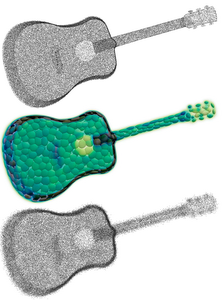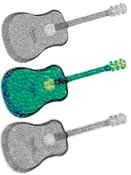Information
- Publication Type: Master Thesis
- Workgroup(s)/Project(s):
- Date: March 2022
- Date (Start): 1. January 2021
- Date (End): 10. March 2022
- TU Wien Library:
- Second Supervisor: Adam Celarek

- Diploma Examination: 10. March 2022
- First Supervisor: Michael Wimmer

Abstract
Point clouds are a common representation of three-dimensional shapes in computer graphics
and 3D-data processing. However, in some applications, other representations are more useful.
Gaussian Mixture Models (GMMs) can be used as such an alternative representation. A GMM
is a convex sum of normal distributions, which aims to describe a point cloud’s density. In
this thesis, we investigate both visualization and construction of GMMs. For visualization,
we have implemented a tool that enables both isoellipsoid and density visualization of GMMs.
We describe the mathematical backgrounds, the algorithms, and our implementation of this
tool. Regarding GMM construction, we investigate several algorithms used in previous papers
for constructing GMMs for 3D-data processing tasks. We present our implementations of the
expectation-maximization (EM) algorithm and top-down HEM. Additionally, we have adapted
the implementation of geometrically regularized bottom-up HEM to produce a fixed number of
Gaussians. We evaluate these three algorithms in terms of the quality of their generated GMMs.
In many cases, the statistical likelihood, which is maximized by the EM algorithm, is not a
reliable indicator for a GMM’s quality. Therefore, we instead rely on the reconstruction error of a
reconstructed point cloud based on the Chamfer distance. Additionally, we provide metrics for
measuring the reconstructed point cloud’s uniformity and the GMM’s variation of Gaussians. We
demonstrate that EM provides the best results in terms of these metrics. Top-down HEM is a fast
alternative, and can produce even better results when using fewer input points. The results of
geometrically regularized bottom-up HEM are inferior for lower numbers of Gaussians but it can
create good GMMs consisting of high numbers of Gaussians very eciently.
Additional Files and Images
Additional images and videos
Additional files
Weblinks
BibTeX
@mastersthesis{FRAISS-2022-CGMM,
title = "Construction and Visualization of Gaussian Mixture Models
from Point Clouds for 3D Object Representation",
author = "Simon Maximilian Fraiss",
year = "2022",
abstract = "Point clouds are a common representation of
three-dimensional shapes in computer graphics and 3D-data
processing. However, in some applications, other
representations are more useful. Gaussian Mixture Models
(GMMs) can be used as such an alternative representation. A
GMM is a convex sum of normal distributions, which aims to
describe a point cloud’s density. In this thesis, we
investigate both visualization and construction of GMMs. For
visualization, we have implemented a tool that enables both
isoellipsoid and density visualization of GMMs. We describe
the mathematical backgrounds, the algorithms, and our
implementation of this tool. Regarding GMM construction, we
investigate several algorithms used in previous papers for
constructing GMMs for 3D-data processing tasks. We present
our implementations of the expectation-maximization (EM)
algorithm and top-down HEM. Additionally, we have adapted
the implementation of geometrically regularized bottom-up
HEM to produce a fixed number of Gaussians. We evaluate
these three algorithms in terms of the quality of their
generated GMMs. In many cases, the statistical likelihood,
which is maximized by the EM algorithm, is not a reliable
indicator for a GMM’s quality. Therefore, we instead rely
on the reconstruction error of a reconstructed point cloud
based on the Chamfer distance. Additionally, we provide
metrics for measuring the reconstructed point cloud’s
uniformity and the GMM’s variation of Gaussians. We
demonstrate that EM provides the best results in terms of
these metrics. Top-down HEM is a fast alternative, and can
produce even better results when using fewer input points.
The results of geometrically regularized bottom-up HEM are
inferior for lower numbers of Gaussians but it can create
good GMMs consisting of high numbers of Gaussians very
eciently.",
month = mar,
address = "Favoritenstrasse 9-11/E193-02, A-1040 Vienna, Austria",
school = "Research Unit of Computer Graphics, Institute of Visual
Computing and Human-Centered Technology, Faculty of
Informatics, TU Wien",
URL = "https://www.cg.tuwien.ac.at/research/publications/2022/FRAISS-2022-CGMM/",
}

 Master thesis
Master thesis poster
poster


